

 |
 |
If you have been a long time follower of my site you will know that I've always been a fan of hunting lunar rainbows or 'moonbows' as they are better known. I bagged my first photogenic moonbows with my old bridge camera back in 2008 and during the following years I continued hunting these elusive bows with my DSLR on nights when their formation seemed particularly worthwhile. However in the last few years I haven't observed many, any which I did see were accidental while shooting other phenomena such as aurora or star trails, in short I hadn't made a pre-mediated decision to specifically hunt for them for a long time. I decided to change all that on Friday August 24th 2018, Dungannon photographer John Fagan and I had planned a shoot, originally we were going to shoot a moonlit time lapse along the Antrim coast however models indicated a greater frequency of showers and cloud in that area not to mention on-shore wind gusts between 20-30mph, this wouldn't work for a time lapse shoot with no shelter so instead we made plans for somewhere inland, it didn't take long to dedicate this shoot to moonbows, we also decided on the new wind turbines above Swatragh for foreground interest, the plan was set, we decided to meet at 21.30 BST.
I met John at the car park outside Swatragh, it was still evening twilight however there was still time for darkness, we needed a darker background sky to spot moonbows so we waited and chatted and had a brew and snacks. It's amazing how quick the seasons have changed, it didn't seem that long ago that I was cooking under a hot sun with 30C temperatures and enjoying balmy nights with NLCs, now it was a different story, colder, windy, and very unsettled, it absolutely looked and felt like Autumnal weather. For the first time in many months I was wearing two layers and even a thermal layer below those, I'm glad I did because gazing towards the mountain showed big showers rattling in, it looked like it was going to be cold in the exposure up there. When the light had darkened sufficiently we began the drive up the mountain and arrived in the midst of wind turbines.
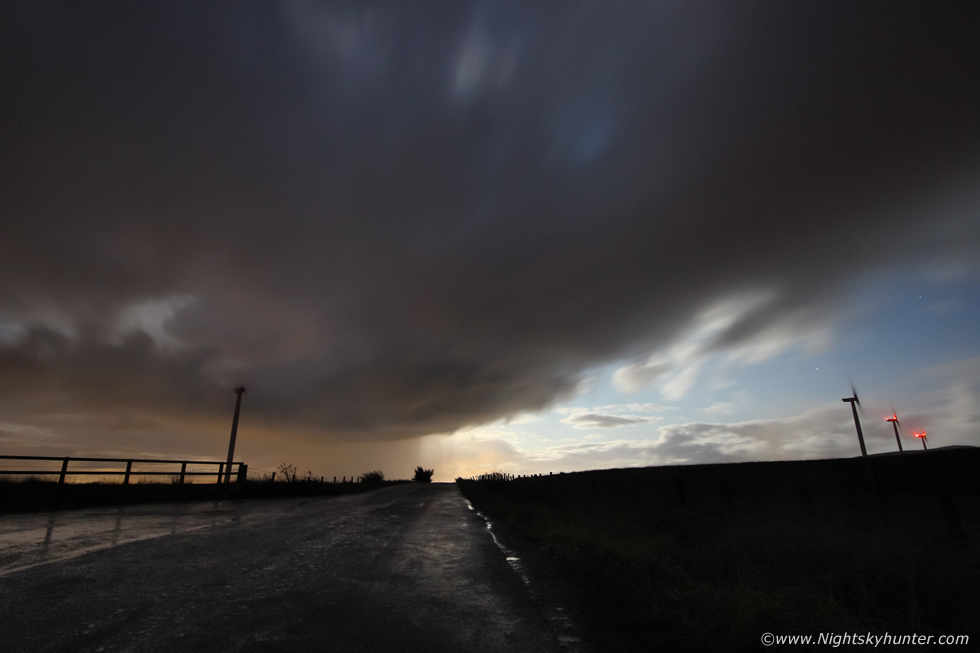 |
Upon arrival we spent a good half hour waiting to get out from the vans due to long duration downpours, once the first cluster passed we got out for a look and a few test exposures. This was the rear of a passing cell in a 13 sec exposure, you can make out a compact updraught base with precip core below it, meanwhile the cell was backlit by the moon, it made for a dramatic sight.
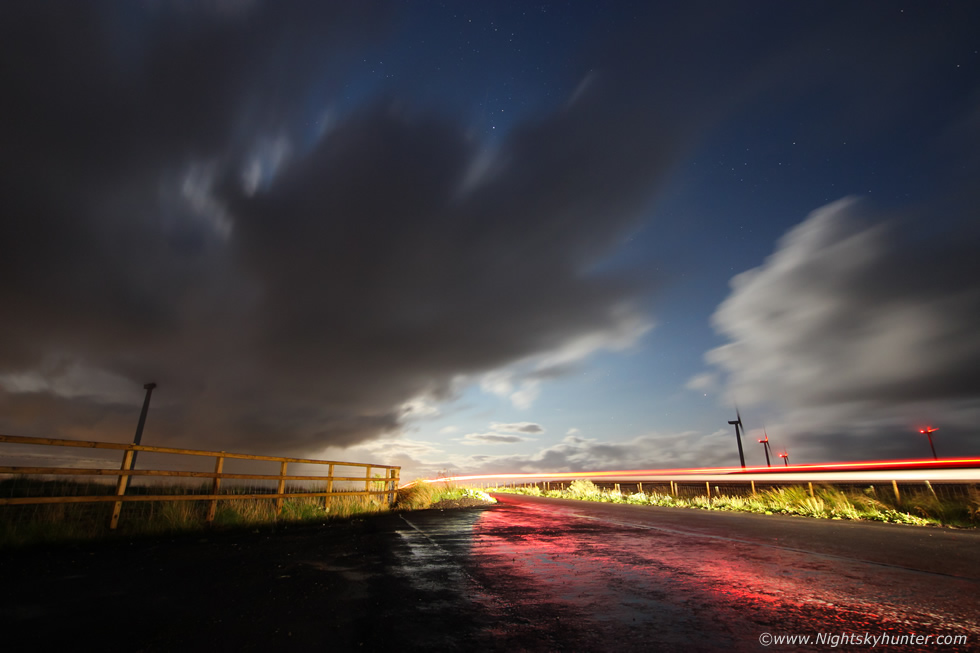 |
A passing car provided us with a chance of capturing a light trail with the clouds, I dropped the ISO and used a longer shutter to get the full trail, we were only out from the vans 10 min's and already getting treated to cool scenes, even if we didn't get to see any moonbows at least we were certainly getting treated to dramatic night cloudscapes, check out the mid and upper level clouds blurring fast in the exposure due to the presence of stronger winds aloft.
 |
A nice clearance arrived and all the stars were out, the night was beautiful and the moon lit up our landscape in dramatic fashion. The conditions certainly looked prime for moonbow formation. We had a clean unstable post frontal maritime air mass behind a cold front with regular showers blowing in on a NWly flow for much of the night. The moon itself was a waxing gibbous two days from full phase which is significantly bright enough to generate bright bows. As long as we kept the moon to our backs we should see a moonbow somewhere within the lunar opposition sky sectors. The moon needs to be less than 42 degrees in altitude to form a moonbow, normally the moon would be much higher at this phase during the Autumn and Winter months which makes moonbows less likely during that period, in fact, my preferred time is some two days after full phase onwards. By great fortune the ecliptic was much lower in late Summer which meant the moon would be lower in the sky and inside the moonbow friendly zone all night long, something which doesn't happen very often.
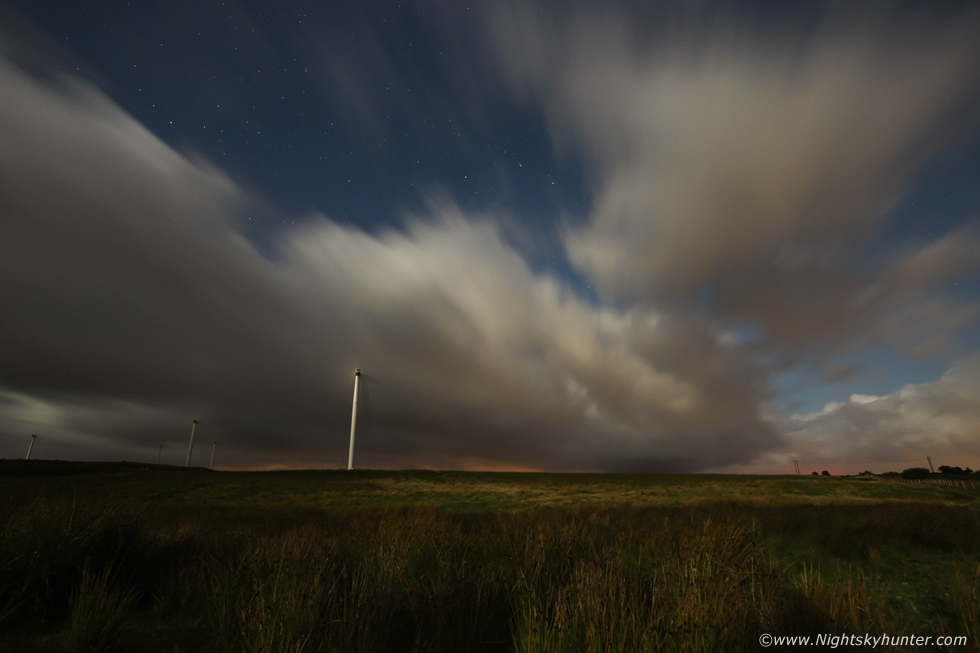 |
We climbed over a gate and ventured over wild terrain which provided us with a terrific open horizon with wind turbines, for some reason many of the turbines had their red lights turned off but luckily for us the moon helped them stand out in our exposures. The cloudscapes really were beautiful this night, clearly convective in nature even at this hour, there had been a risk of thunderstorms earlier in the afternoon which never materialized however the marginally unstable air, -20C temperature aloft and good lapse rates continued to aid with cumulus growth which rapidly evolved into heavy showers. The showers lit by the moonlight looked stunning with the naked eye and on camera, we faced our cameras to the N and began shooting a time lapse, I was using my 600D and 10mm F/2.8 Samyang with aperture wide open.
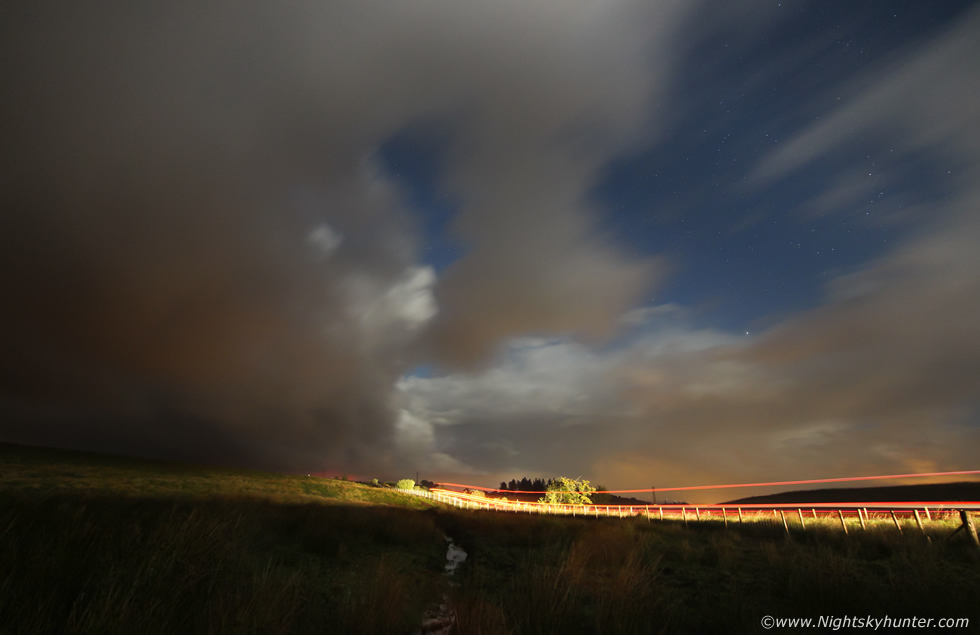 |
The night turned dark as a cell approached, John spotted a very faint moonbow, the first of the night, embedded within the dark core just as the wind picked up and rain drops began to fall on us, we stopped our time lapse before the onslaught of rain. I turned my camera to the NE for one last exposure, this was the cell racing straight towards us, the leading edge, look how low the clouds are to the surface, I was pretty sure there was a weak gust front feature on that leading edge, another car obliged me with a light trail then we raced back to the vans and sat under another a long duration downpour.
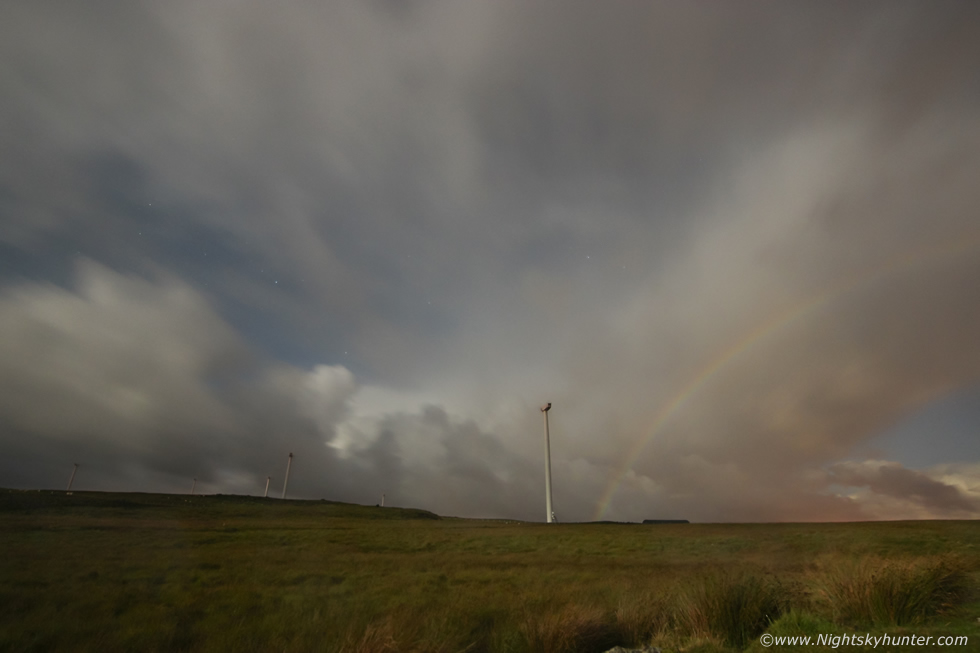 |
Once the sky cleared once more we hiked back into the marshland, this time much further, then set up our gear at a location which seemed suitable, thankfully the wind had eased somewhat and it was much more comfortable outside, the drawback was that if more downpours arrived we would be too far from the vans to take shelter and would just have to stick it out, however we didn't care because being out on this moonlit landscape under the stars was a complete joy. We began shooting a second time lapse, I was on 15 sec's, ISO800, F/2.8 at 10mm, John was being a pure savage professional with two DSLRs with two different lenses shooting time lapse simultaneously. Another line of convection arrived over the horizon and in no time it was upon us and it did generate a moonbow, this one was complete, filling the northern celestial dome, I captured the NW side, it was visible for a long time and it was an easy naked eye sight, however rain drops began to assault the camera lens killing the clarity of the scene, I let the camera continue on anyway.
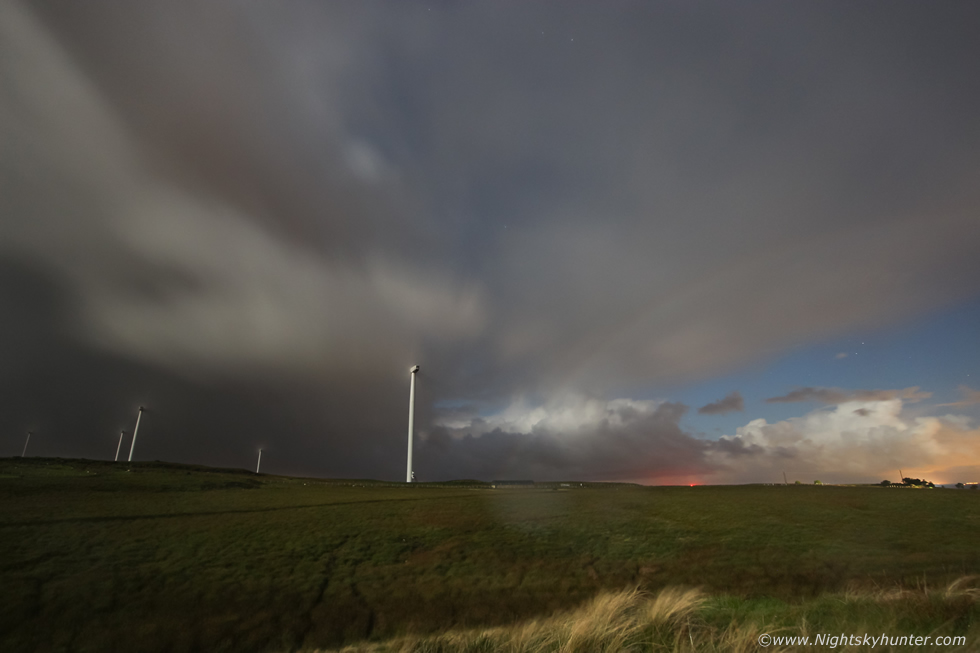 |
My lens was soaking at this stage, a large drop can be seen at image centre, I kept stopping to wipe and continue shooting, then more drops would splash the glass, the bow was fading however I still liked the scene with dark clouds contrasting against clear sky with new moonlit convection already announcing their presence in the distance.
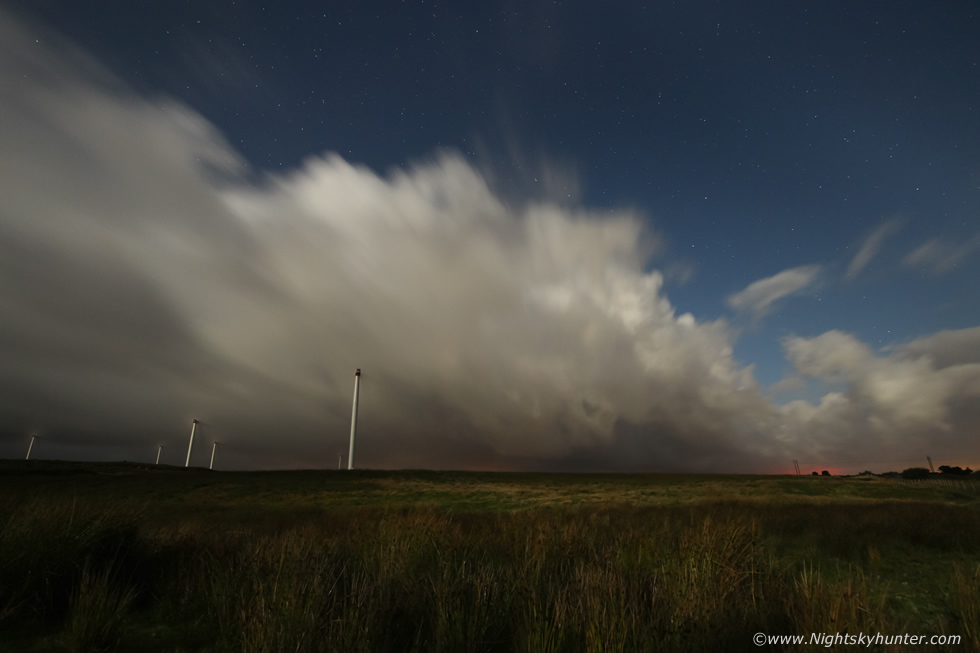 |
We loved shooting convective weather in moonlight, there's nothing like it, this beautiful cell crept in over the open marshland, flank and updraughts all lit by bright moonlight, surrounded by stars and under lit by distant lights, you can see the stars of Ursa Major and Draco above the cloud tops.
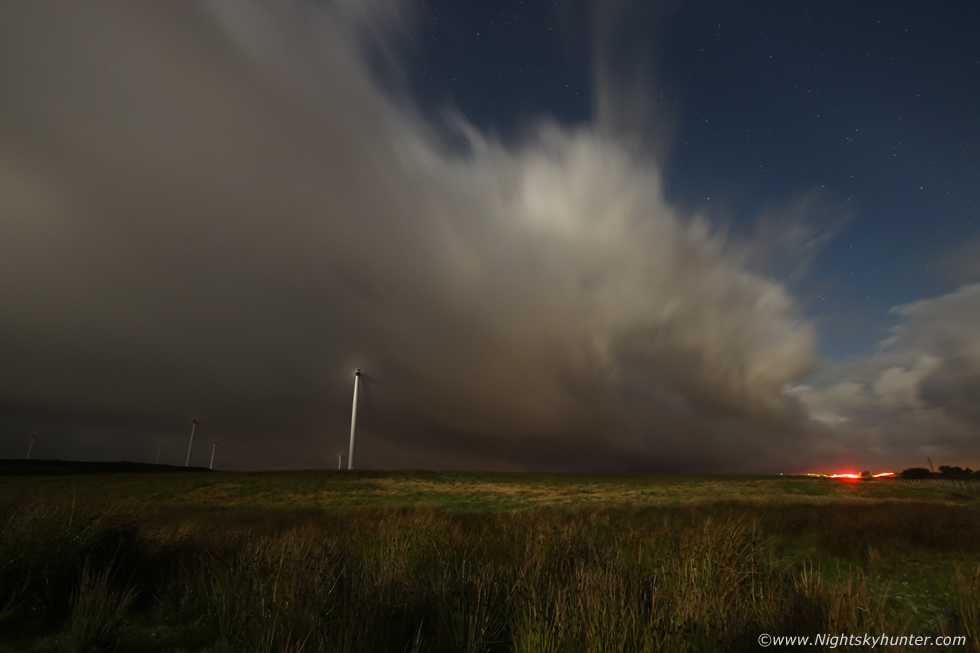 |
The clouds really stole the show for us, for me at least they were the photogenic highlights from the night, this dramatic scene was my favourite image from the shoot, convective cell with cloud motion captured in the exposure with stars, you can see a faint moonbow present to the right of the main turbine.
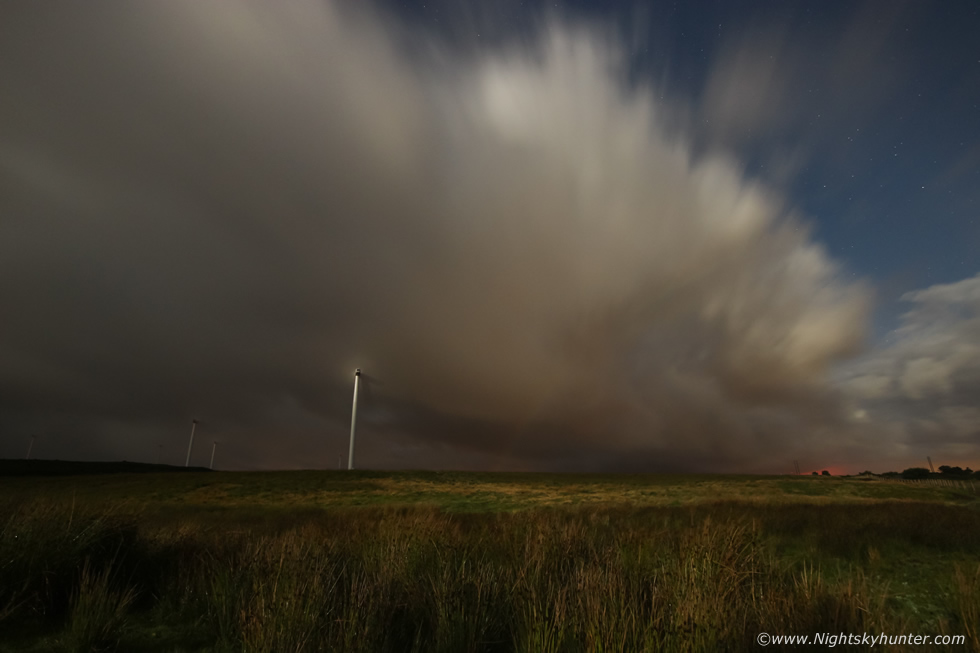 |
Moonbow growing but at the same time rain was blowing on the gear and our faces once more so we stopped shooting and waited out. During this period we witnessed several more moonbows, complete, however against a background of dark cloud.
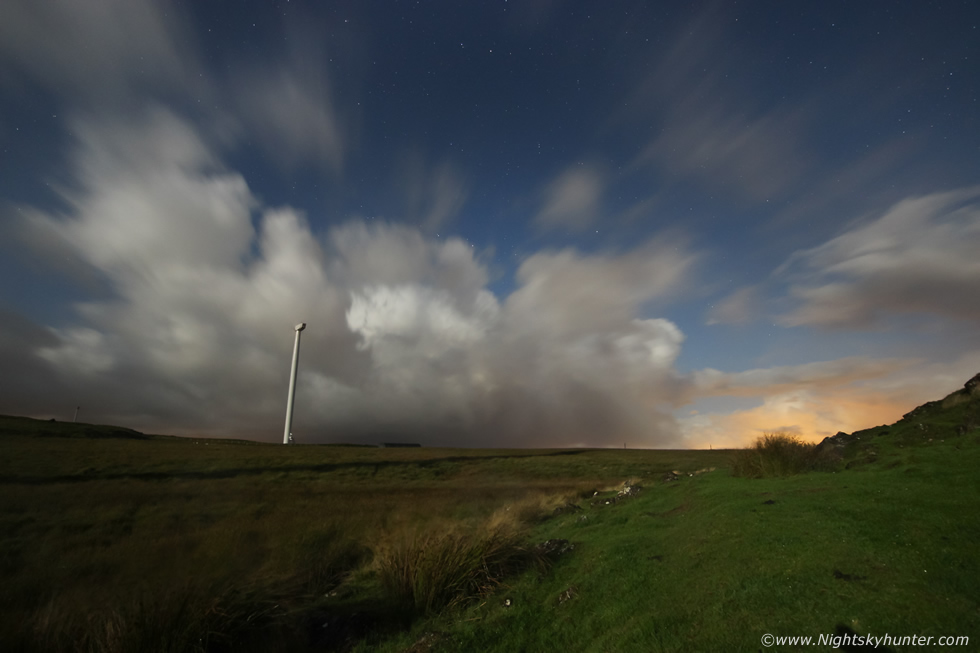 |
Cameras cleaned, then set up one more time for the next round of convection, at this stage we were getting cold from the exposure and from standing still on the damp ground however the scenes were so photogenic we decided to stay a little longer. It never ceases to amaze me how bright the landscape can get under a moon of advanced phase, some my express shock at colours in images, keep in mind that the colours are still there at night, it's just that our eyes cant see this colour due to the darkness, improved dark adaption helps however this is generated by the rods on the side of your eyes during averted vision. The more central cones are best for observing colour however they require a bright light source to see this colour, a bright moon can do this, next time you are in the countryside under a full moon (or several days either side) check out how much colour you can see with your eye, now imagine a time exposure of 15-25 sec's with a DSLR and fast lens and you can see why the world looks so bright and vivid on camera, the colours are always there, however it's the more sensitive eye of the camera which reveals them.
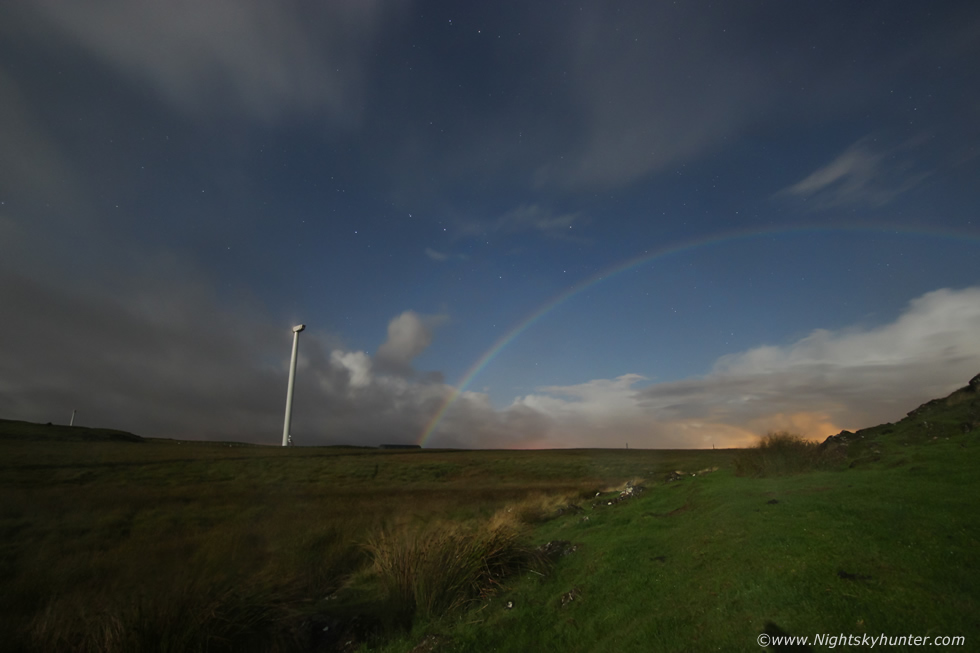 |
The next moonbow was the highlight of the night, this one formed against a clear sky background with stars which greatly aids with their unworldly presence. The best moonbow images need stars in the frame, if the scene is full of cloud the untrained eye looking at your image may accuse you of taking a rainbow image in daytime, however stars in the frame are an instant give away that the rainbow was captured at night. If you look closely you may see the hint of a much fainter and more rare secondary moonbow. The image looks slightly 'soft' due to rain drops and smearing from lens wiping. I wonder, had all the red lights been on these turbines would the images have looked even better?, I will find out on another night.
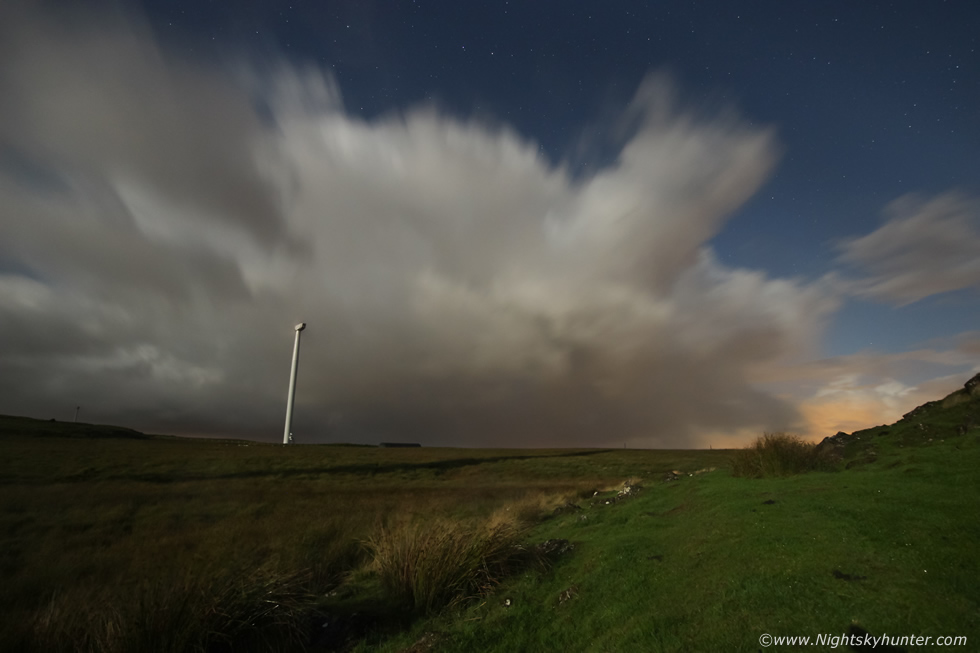 |
Big cell with heavy precip inbound, we were now cold and craving tea and a snack so we packed up and began our walk back to the vans, during this walk the best moonbow of the night appeared so we simply enjoyed it visually as we walked, just taking in the eerie spectacle. Back at the vans we enjoyed a warm brew and yet another bow formed in front of us, this brought our total to nine observed moonbows. At 02.00 BST we called it a night and headed home, we considered this photo shoot a total success, we hoped to observe one moonbow, however we accepted the possibility of seeing none if cloud cover was too thick or if shower activity died down, however as it happens conditions were perfect and we got spoiled, our results were complimented by beautiful cloudscapes. In earlier years I have witnessed much brighter moonbows than these, in fact, some of them were exceptional with bright secondary arcs, vivid colours and even supernumerary arcs. These moonbows were still special, they revealed their fleeting secrets to us and let us come home with a record of their beauty on camera and for that we couldn't have asked for more. if you are interested in spotting your own moonbow then why not check out this article on the subject which I wrote a few years ago.
If you enjoyed this report on moonbow hunting then why not re-visit my older moonbow observing exploits on the links below...
Spectacular Moonbows Over Maghera - September 13th 2011 REPORT
Moonbow Hunting - Nov 11th/12th 2008 - REPORT
Sperrin Mountain Moonbows - Oct 15th & 16th 2018 - TWO PAGE REPORT
Twilight Convection & Haunting Moonbows - 19.7.08 - REPORT
Ballintoy Harbour Moonlit Showers, Stars, Moonbow & Seals - Oct 2nd 2012 - REPORT
Moonlit Ocean Storms Moonbows & Snow - December 2012 - REPORT
Short time lapse sequence from the shoot showing moonlit convection, stars and two moonbows, the bows are fleeting for they were only recorded on a smaller number of frames, when the footage is rendered at 24 frames/sec they are a fraction of the actual time in reality, that being said I hope you enjoyed the lapse. I will no doubt be shooting more moonbows this season, my goal has always been to capture a vivid moonbow with aurora, with lightning or over moonlit snow, thanks for reading.
Martin McKenna